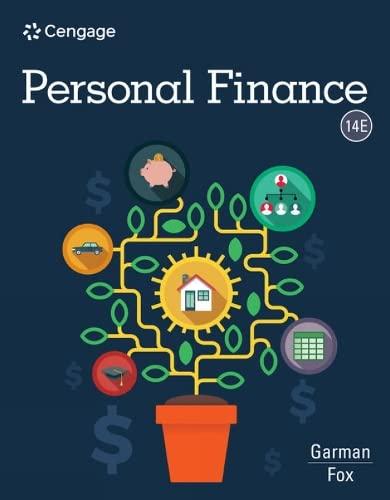Question
Final Answer Please question 13. Assume that you own an annuity that will pay you $15,000 per year for 12 years, with the first payment
Final Answer Please
question 13. Assume that you own an annuity that will pay you $15,000 per year for 12 years, with the first payment being made today. You need money today to start a new business, and your uncle offers to give you $128,000 for the annuity. If you sell it, what rate of return would your uncle earn on his investment? a. 8.36% b. 5.73% c. 6.77% d. 6.91% e. 5.32% QUESTION 11 1. All other things held constant, the present value of a given annual annuity decreases as the number of periods per year increases. True False QUESTION 12 1. Which of the following statements is CORRECT? a. A time line is not meaningful unless all cash flows occur annually. b. Time lines can only be constructed for annuities where the payments occur at the end of the periods, i.e., for ordinary annuities. c. Time lines can be constructed where some of the payments constitute an annuity but others are unequal and thus are not part of the annuity. d. Time lines are not useful for visualizing complex problems prior to doing actual calculations. e. Time lines cannot be constructed to deal with situations where some of the cash flows occur annually but others occur quarterly.
QUESTION 13 1. You are considering two equally risky annuities, each of which pays $5,000 per year for 10 years. Investment ORD is an ordinary (or deferred) annuity, while Investment DUE is an annuity due. Which of the following statements is CORRECT? a. The present value of ORD must exceed the present value of DUE, but the future value of ORD may be less than the future value of DUE. b. If the going rate of interest decreases from 10% to 0%, the difference between the present value of ORD and the present value of DUE would remain constant. c. The present value of DUE exceeds the present value of ORD, while the future value of DUE is less than the future value of ORD. d. The present value of ORD exceeds the present value of DUE, and the future value of ORD also exceeds the future value of DUE. e. The present value of DUE exceeds the present value of ORD, and the future value of DUE also exceeds the future value of ORD.
QUESTION 14 1. Which of the following statements is CORRECT? a. The proportion of the payment that goes toward interest on a fully amortized loan increases over time. b. If a loan has a nominal annual rate of 8%, then the effective rate can never be greater than 8%. c. If a loan or investment has annual payments, then the effective, periodic, and nominal rates of interest will all be different. d. An investment that has a nominal rate of 6% with semiannual payments will have an effective rate that is smaller than 6%. e. The present value of a 3-year, $150 annuity due will exceed the present value of a 3-year, $150 ordinary annuity.
QUESTION 15 1. Time lines cannot be constructed in situations where some of the cash flows occur annually but others occur quarterly. True False
QUESTION 16 1. Which of the following statements is CORRECT? a. An investment that has a nominal rate of 6% with semiannual payments will have an effective rate that is smaller than 6%. b. If a loan has a nominal annual rate of 8%, then the effective rate will never be less than 8%. c. If a loan or investment has annual payments, then the effective, periodic, and nominal rates of interest will all be different. d. The proportion of the payment that goes toward interest on a fully amortized loan increases over time. e. The present value of a 3-year, $150 ordinary annuity will exceed the present value of a 3-year, $150 annuity due.
Final Answer Please , no need to explain
Step by Step Solution
There are 3 Steps involved in it
Step: 1

Get Instant Access to Expert-Tailored Solutions
See step-by-step solutions with expert insights and AI powered tools for academic success
Step: 2

Step: 3

Ace Your Homework with AI
Get the answers you need in no time with our AI-driven, step-by-step assistance
Get Started


